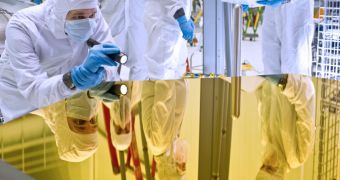Scientists with the NASA Goddard Space Flight Center (GSFC) announce that they have just received two brand-new mirrors at their facility. The devices are unique, and their role is to enable the James Webb Space Telescope (JWST) to see farther into the cosmic past than possible before.
The observatory is currently scheduled to launch around 2015, but its mission will be as critical then as it is know – learning as much as possible about the earliest days of the Universe. Doing so is a tremendously complex task.
The instrument needs to be cooled to extremely-low temperatures, and needs to have perfect mirrors and optics systems. The two new mirrors that made their way to the GSFC are extremely important for this job. They represent two new classes of mirrors altogether.
Both of them need to work together, in order to allow the telescope the necessary field-of-view and resolution it needs to conduct valid science. The JWST will be the most complex and technologically-advanced piece of equipment ever sent to outer space.
The Primary and Secondary Mirror Engineering Design Units (EDU) that GSFC engineers received were sent by experts at the Redondo Beach, California-based Northrop Grumman Aerospace Systems.
This company is the main contractor the GSFC selected for constructing the huge instrument. “The Primary mirror EDU will be used next year to check out optical test equipment developed by Goddard and slated to be used to test the full Flight Primary mirror,” expert Lee Feinberg.
“Following that, the primary and secondary EDU will actually be assembled onto the Pathfinder telescope,” adds the scientist, who is the GSFC JWST Optical Telescope Element manager.
“The Pathfinder telescope includes two primary mirror segments (one being the Primary EDU) and the Secondary EDU and allows us to check out all of the assembly and test procedures (that occur both at Goddard and testing at Johnson Space Center, Houston, Texas) well in advance of the flight telescope assembly and test,” he explains.
Overall, the telescope's primary eyes will be made up of 18 hexagonal mirror segments, that will all combine to form a giant, 6.5-meter (21-feet 4 inches) main mirror. According to astrophysicists, this is the diameter the instrument needs to have in order to see the earliest stars in the Universe.
When the JWST will launch, it will be placed at the L2 Lagrangian point, which is a point some 1.5 million kilometers away from Earth where any object remains in the same relative position in respect to the Earth-Sun-Moon system.
This orbit enables sophisticated telescopes to shield themselves from light radiation via a sunshield, and to conduct very complex observations in pitch-black darkness.

 14 DAY TRIAL //
14 DAY TRIAL //